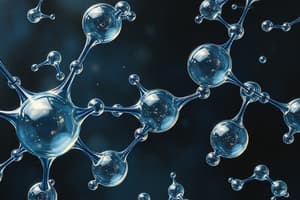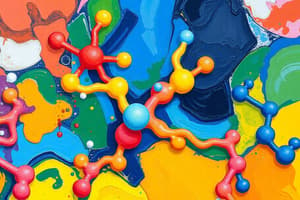Podcast
Questions and Answers
Which of the following biomolecules is responsible for storing and transmitting genetic information?
Which of the following biomolecules is responsible for storing and transmitting genetic information?
- Lipids
- Carbohydrates
- Nucleic acids (correct)
- Proteins
Which of the following is NOT a biological role of electrons?
Which of the following is NOT a biological role of electrons?
- Catalysis
- Cellular respiration (correct)
- Energy transfer
- Signal transduction
Which of the following bonds is the strongest?
Which of the following bonds is the strongest?
- Hydrogen bond
- Van der Waals interaction
- Covalent bond (correct)
- Ionic bond
Which of the following best describes the solubility of polar molecules in water?
Which of the following best describes the solubility of polar molecules in water?
How is molecular shape related to molecular function?
How is molecular shape related to molecular function?
Which of the following best describes an acid?
Which of the following best describes an acid?
What is the main function of soluble proteins in the body?
What is the main function of soluble proteins in the body?
Which of the following best describes the composition of biomolecules?
Which of the following best describes the composition of biomolecules?
Which of the following is NOT a major group of biomolecules?
Which of the following is NOT a major group of biomolecules?
Which of the following bonds is a type of noncovalent bond?
Which of the following bonds is a type of noncovalent bond?
Which of the following best describes the structure of polar molecules?
Which of the following best describes the structure of polar molecules?
Which of the following best describes the meaning of affinity in protein-ligand binding?
Which of the following best describes the meaning of affinity in protein-ligand binding?
Which of the following best describes the meaning of specificity in protein-ligand binding?
Which of the following best describes the meaning of specificity in protein-ligand binding?
Which of the following best describes the meaning of pH?
Which of the following best describes the meaning of pH?
Which of the following is essential for understanding the pathology of demyelinating diseases and nerve conduction velocity?
Which of the following is essential for understanding the pathology of demyelinating diseases and nerve conduction velocity?
Which of the following is fundamental for comprehending the structure and function of the mature nervous system?
Which of the following is fundamental for comprehending the structure and function of the mature nervous system?
Which of the following is crucial for any healthcare practitioner who will work with the nervous system?
Which of the following is crucial for any healthcare practitioner who will work with the nervous system?
Which of the following is vital for assessing and treating patients with communication disorders or neurological conditions affecting language?
Which of the following is vital for assessing and treating patients with communication disorders or neurological conditions affecting language?
Which of the following best describes the function of the cell membrane?
Which of the following best describes the function of the cell membrane?
Which of the following best describes the structure of the cytoskeleton?
Which of the following best describes the structure of the cytoskeleton?
Which of the following best describes the function of soluble proteins in the body?
Which of the following best describes the function of soluble proteins in the body?
Which of the following best describes the meaning of competition in protein-ligand binding?
Which of the following best describes the meaning of competition in protein-ligand binding?
Which of the following is crucial for understanding how hormones initiate cellular responses and allows for precise therapeutic interventions?
Which of the following is crucial for understanding how hormones initiate cellular responses and allows for precise therapeutic interventions?
Which of the following is essential for recognizing and managing endocrine disorders by regulating various physiological processes?
Which of the following is essential for recognizing and managing endocrine disorders by regulating various physiological processes?
Which of the following is crucial for recognizing, diagnosing, and treating common endocrine pathologies such as diabetes and thyroid disorders?
Which of the following is crucial for recognizing, diagnosing, and treating common endocrine pathologies such as diabetes and thyroid disorders?
Which of the following is fundamental in comprehending hormonal imbalances and diseases like diabetes and thyroid disorders by regulating hormone release and target cell responses?
Which of the following is fundamental in comprehending hormonal imbalances and diseases like diabetes and thyroid disorders by regulating hormone release and target cell responses?
Which of the following best describes the role of T cells in the immune system?
Which of the following best describes the role of T cells in the immune system?
Which of the following best describes the relationship between the immune system and the nervous and endocrine systems?
Which of the following best describes the relationship between the immune system and the nervous and endocrine systems?
Which of the following best describes the role of glial cells in the nervous system?
Which of the following best describes the role of glial cells in the nervous system?
Which of the following best describes the relationship between stress and immunity?
Which of the following best describes the relationship between stress and immunity?
Which of the following best describes the role of calcium in bone remodeling?
Which of the following best describes the role of calcium in bone remodeling?
Which of the following best describes the difference between hypertrophy and hyperplasia?
Which of the following best describes the difference between hypertrophy and hyperplasia?
Which of the following best describes the role of leukocytes in the immune response?
Which of the following best describes the role of leukocytes in the immune response?
Which of the following best describes the role of antigen-presenting cells (APCs) in the immune response?
Which of the following best describes the role of antigen-presenting cells (APCs) in the immune response?
Which of the following is fundamental to understanding the structure and function of the mature nervous system?
Which of the following is fundamental to understanding the structure and function of the mature nervous system?
What is crucial for any healthcare practitioner who will work with the nervous system?
What is crucial for any healthcare practitioner who will work with the nervous system?
Why is knowledge about cerebrospinal fluid vital?
Why is knowledge about cerebrospinal fluid vital?
Why is understanding the blood-brain barrier essential?
Why is understanding the blood-brain barrier essential?
What does LO 9.4.1 explain the organization of in the spinal cord?
What does LO 9.4.1 explain the organization of in the spinal cord?
Which of the following is NOT explained by LO 9.4.1?
Which of the following is NOT explained by LO 9.4.1?
Which of the following best describes the difference between apoptosis and necrosis?
Which of the following best describes the difference between apoptosis and necrosis?
Which of the following best describes the difference between pluripotent, multipotent, and totipotent stem cells?
Which of the following best describes the difference between pluripotent, multipotent, and totipotent stem cells?
Which of the following best describes the difference between kinetic and potential energy?
Which of the following best describes the difference between kinetic and potential energy?
Which of the following best describes the first and second laws of thermodynamics?
Which of the following best describes the first and second laws of thermodynamics?
Flashcards are hidden until you start studying




